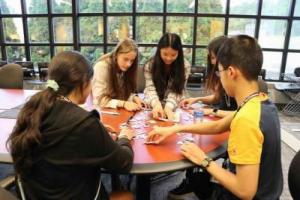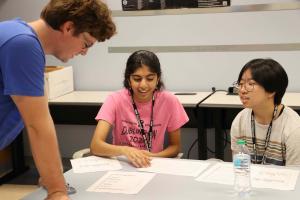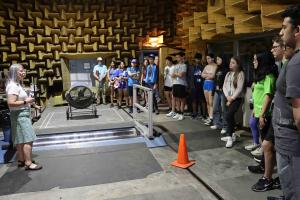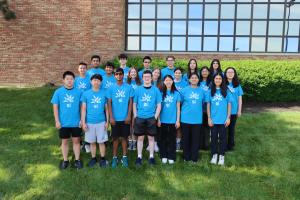The Ohio Supercomputer Center (OSC) doubled enrollment in its Summer Institute (SI) this year to offer more Ohio teens the opportunity to learn how to use high performance computing skills in topical STEM areas such as data analysis, machine learning and cybersecurity. During the program students attended tours of research facilities and museums, collaborated in teams to complete STEM projects and engaged in social activities such as soccer and volleyball.

“This year we split the camp into two sessions, each hosting 20 students,” said Alan Chalker, director of strategic programs at OSC. “Our goal was to expose as many kids as possible to diverse fields of science they may not have encountered before, and the approach proved very successful.”
Besty Kordes, conference planner for educational programming, said the best part of SI is that students are exposed to different careers and areas of research.
“It really opens the students’ perspective to see how coding, machine learning or research data could be utilized as a career in the future, and better yet, something specific that they can develop an education pathway for here in Ohio,” Kordes said.
In addition to academic pursuits, the program immersed students in college life, allowing them to stay in The Ohio State University’s residence halls, dine on campus and use university recreational facilities. SI also offered students the chance to connect with peers who share similar interests and passions in STEM. Throughout the week, students grew closer, sharing laughter and introducing their parents to their new friends by the end of the program.
Reflecting on their experiences, one student remarked in an exit survey, “I feel like SI has helped me explore more programming languages and advance my coding/engineering knowledge for my future. I was already interested in going into computer/engineering, so this was a valuable experience for me.”
Projects
Projects led by OSC experts, a central part of the SI program, engaged students in various hands-on activities aimed at teaching them about supercomputing and its applications.
-
Web App Development: Students created a web application that displayed computer-generated videos using the Center’s clusters. They gained experience with Ruby programming language, the Linux operating system and web technologies including HTML, JavaScript and CSS.
-
Machine Learning Movie Night: Students used Python and scikit-learn software to develop a basic machine learning model to generate text encodings that predicted the positive or negative sentiment of movie reviews and classified them accordingly. The students also worked on more self-directed projects in which they chose to analyze Spotify songs.
-
Penetration Testing: This project gave students the opportunity to perform authorized cyberattacks on computer systems to understand how to defend against hackers. They learned to identify vulnerabilities, assess security controls and prevent unauthorized access.
-
Comet Hunting: During this project, students utilized MATLAB to analyze data from the Solar and Heliosphere Observatory (SOHO) Spacecraft and the Large Angle Spectrometric Coronagraph (LASCO) Instrument to identify potential comets.
Samuel Seibert, client service specialist at OSC, helped lead the comet hunting project and was impressed by how quickly students were able to become familiar with the project’s topics.
“I was taken aback by the aptitude and promise that these high schoolers demonstrated,” Seibert said. “No matter the background or knowledge coming into the program, every student was able to find their own way to help their projects.”

Evan Jaffe, a machine learning engineer at OSC, led the machine learning movie night and was struck by the students’ prior knowledge of the field of machine learning.
“I was happy to see them try their hand at coding in Python and was impressed by their attitude,” Jaffe said. “It’s easy to get discouraged learning a new skill, but they took it in stride and I think they gained confidence.”
By participating in these projects, students gained important skills in programs they may use in future careers.
“Learning MATLAB was very beneficial to potential future career paths, and I am now considering a future in a physics-based discipline, which I was not before,” one student wrote in the exit survey.
Tours
Throughout the camp, students participated in five tours where they explored various scientific fields, including supercomputing, automotive research and biodiversity.
During a chemistry demonstration at an Ohio State laboratory, students learned practical applications of liquid nitrogen and methane, even enjoying ice cream made with liquid nitrogen. On their way back they made a stop at Thompson Library where they viewed Ohio State’s campus from the 11th floor.
At the Museum of Biological Diversity, students learned how supercomputers aid the analysis of different species preserved at the museum, which highlighted the efficiency of the technology.

During a tour of the Center for Automotive Research (CAR), students observed automotive projects developed by current undergraduate and graduate Ohio State students, which offered insights into potential future projects they could take part in.
Led by Chalker, a tour of the State of Ohio Computer Center (SOCC) included a visit to OSC’s data center, where students learned about the high performance computing systems’ components and operations.
At the Byrd Polar and Climate Research Center, students were educated on the procedures involved in collecting ice cores and rocks for research, as well as the valuable data extracted from each sample. They also had the opportunity to explore the rock garden and were allowed to take home their own Antarctic rock as a memento.
Evening Activities
After working hard on their projects each day, students returned to a residence hall on Ohio State’s Columbus campus and spent their evening with their new friends participating in various activities. Many of the students also used this time to continue working on their projects.
“We set aside time for them to work on their projects during camp, but they were so motivated that many of them worked on their projects in the evening during their free time,” Kordes said.

When they weren’t working on their projects, one popular activity was visiting the Recreational and Physical Activity Center (RPAC), where students engaged in sand volleyball, pool tournaments and soccer.
Overall, the Ohio Supercomputer Center’s Summer Institute offered high school students a rich educational experience that combined academic learning with hands-on projects, exposure to research and a taste of university life.
Students who are interested in applying for next year’s Summer Institute can find more information on the OSC website. Ohio residents currently in the ninth, 10th or 11th grades of high school are eligible to apply for the camp. Applications typically open in January and close in April. Accepted students are notified in May.
Written by Kira Ley.
The Ohio Supercomputer Center (OSC) addresses the rising computational demands of academic and industrial research communities by providing a robust shared infrastructure and proven expertise in advanced modeling, simulation and analysis. OSC empowers scientists with the services essential to making extraordinary discoveries and innovations, partners with businesses and industry to leverage computational science as a competitive force in the global knowledge economy and leads efforts to equip the workforce with the key technology skills required for 21st century jobs.